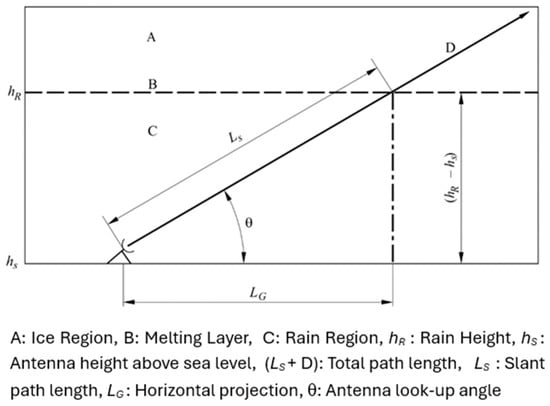The seasonal variations of XPD at the 11.7 GHz, 15 GHz, 20 GHz, 25 GHz, 30 GHz, and 35 GHz computed using the seasonal and ITU recommended rain heights Hr are presented in Figure 2a–f, respectively. Generally, the results show that a lower time percentage of signal unavailability results in a decrease in XPD. This implies that an increase in the cross-talk (CPA) would be experienced in the quest to reduce the percentage of signal unavailability during heavy rainy events. Hence, there is a need to maintain a trade-off between XPD and duration of signal outage due to rain-induced attenuation.
The variation in the XPD across the four seasons is evidently influenced by the seasonal rain heights, albeit with minor differences. The curves in Figure 2a–f indicate that XPDs attain minimal values during the summer season at all frequencies. This is because the summer season is a period characterized by frequent convective rainfalls and maximum rain height in Pretoria, during which rain-induced attenuations attain their peak as reported by Lawal et al. [13]. The intense convective rainfall increases rain-induced attenuation, thereby causing a reduction in XPD. The spring season is a transition period when rainfall and rain height reduce gradually, leading to lower attenuation and a consequential increase in XPD. Rain heights and rain-induced attenuation reach the minimal values in the winter, which results in maximum XPDs as depicted in Figure 2a–f. The low values of rain-induced attenuation during the winter and spring indicate rare rainy events that are usually less intense or involve fewer non-spherical raindrops that could cause depolarization. The maximum XPD, which occurs in the winter, is followed by a gradual decrease during the autumn season, which signifies a transition between the winter and summer. A comparison of the XPD obtained using the annual mean rain height of 4.54 km recommended by ITU with the seasonal XPDs for the study location revealed that the ITU Hr-based XPD slightly underestimates XPD during winter and overestimates during summer, spring, and autumn seasons at various frequencies. These observations agree with the findings of Sen and Singh [25], who applied maximum and minimum rain heights to compute XPD due to rain in Madras, India. From Figure 2a, which presents XPD distribution at 11.7 GHz transmission, it could be observed that at 0.01% of the time, the summer, spring, winter, autumn, and ITU XPDs are 13, 14, 15, 14, and 14 dB, respectively. These represent percentage differences of 7.7%, 0%, 6.7%, and 0% in the summer, spring, winter, and autumn with respect to the ITU XPD of 14 dB. Similarly, at 35 GHz, for the same time percentage of signal unavailability, the summer, spring, winter, autumn, and ITU XPDs are 14, 15, 16, 15, and 16 dB, respectively. These translate to higher percentage differences of 14.3%, 6.7%, 0%, and 6.7% in the summer, spring, winter, and autumn, respectively. The increase in the percentage differences as the frequency increases, especially in the summer, obviously indicates that the effects of rain height variability on XPD are minimal at low frequencies but become significant at higher frequencies.
Source link
Yusuf Babatunde Lawal www.mdpi.com

